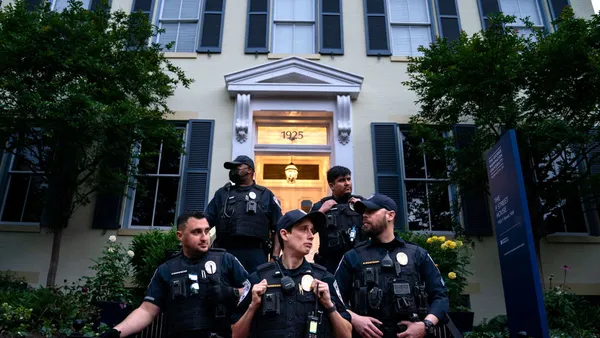Dive Brief:
- Gender pay equity for college administrators is better at women-led schools than those helmed by men, but institutions — especially top research universities — have their work cut out for them to improve female representation in top roles, according to two reports released this month.
- Only about one-third of college presidents are women, according to research from the College and University Professional Association for Human Resources. But senior officers, administrators and division heads who are women are all paid more at institutions with female presidents than at those with male presidents.
- Disparities in leadership are even worse at the 130 universities with the highest research activity, according to a report from the Women's Power Gap Initiative, an effort to increase the number of women in C-suite roles nationwide. Women comprise only 22% of presidents at these institutions.
Dive Insight:
Together, the reports reveal the extent to which gender inequities persist in the upper echelons of college administration. They call on institutions to improve, warning that they won't be as ready to lead in a fast-changing world without diverse management teams.
The CUPA-HR report cited research showing that women in the C-suite in corporations are more open to change and less open to risk.
"In an era where institutions are adapting to shifting workforce expectations, adjusting to continuous decreases in budgets, contemplating changes in enrollment, addressing challenges of recruitment and retention, and rethinking their mission, more openness to change and less tolerance of risk may be just what is needed to navigate this new landscape," its authors wrote.
Women don't just have lower representation at the top. They also get paid less than their male counterparts, with female college presidents earning 91 cents for every dollar male presidents earn, CUPA-HR found.
Similar pay disparities exist at other administrative levels. Female division heads at institutions with male presidents make 94 cents for every dollar their male peers make, for instance. Yet when women in those same roles work at institutions with female presidents, they make $1.06 for every $1 men make.
Women were also better represented in top administrative roles at institutions with female presidents compared to those with male presidents.
The gender of the provost has an influence on parity of roles but not of pay. When women fill these roles, institutions see significantly higher representation of women in dean positions and across all faculty ranks. However, pay equity for faculty and deans does not substantially differ when provosts are women versus men.
Still, the report's authors argue, having more women in these roles affects pay equity because female representation declines with successive faculty ranks.
"These promotions represent the few times in a faculty member's career when appreciable salary increases are granted," they wrote. "If women are not being promoted, they are not receiving these pay raises."
These roles also put more women on the path to the presidency at research universities. That's because men tend to have better access to nontraditional routes to college presidencies compared to women, who typically must have traditional qualifications of rising through academic roles, according to the Women's Power Gap Initiative report.
The authors count someone as taking the traditional route if they ascended to the presidency after serving as a provost or academic dean. Ninety-three percent of women took this path to the presidency, compared to 74% of men.
The higher the rank at top research universities, the more gender disparities widen. While 39% of academic deans are women, only 22% of presidents are. That share shrinks to just 10% when considering only presidents of multi-campus systems.
The report ranked the top research universities with the greatest gender parity in administrative roles and tenured professorships. The University of California, Santa Cruz topped the list, with a current woman president and two past women presidents. The City University of New York Graduate School and the University of New Hampshire rounded out the top three.
At the bottom was the New Jersey Institute of Technology, which has never had a woman president and where only 13% of fully tenured professors are women. Florida International University and the California Institute of Technology were the other schools closest to the bottom.














